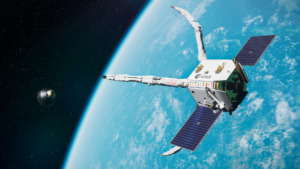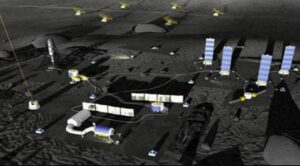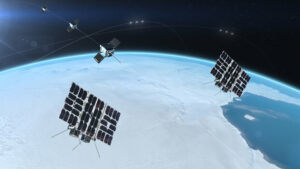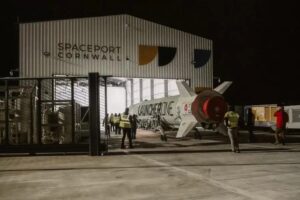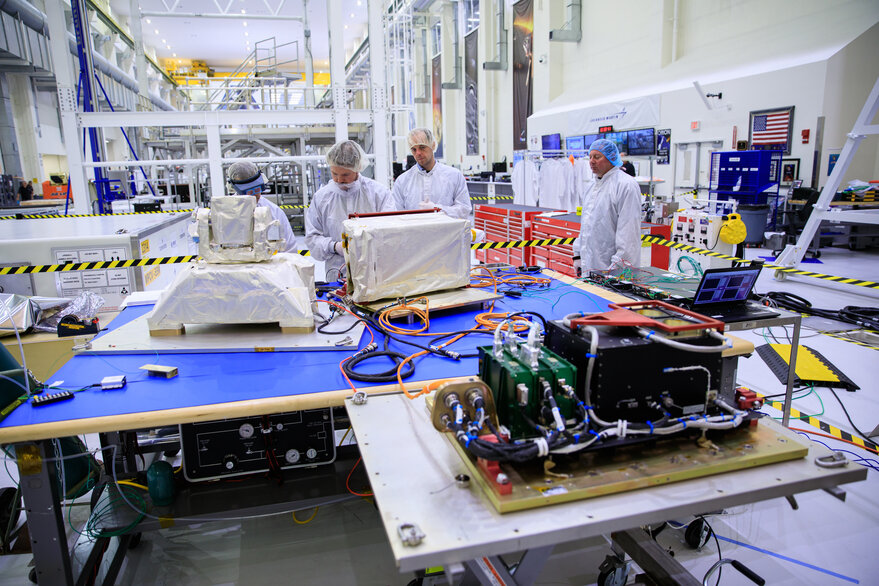
SAN FRANCISCO – NASA has been concentrating on the ground component of optical communications networks while the U.S. Space Force Space Development Agency focuses on space-to-space communications.
The two initiatives will intersect in two-to-three years when NASA determines whether the commercial terminals SDA is adopting for satellite-to-satellite communications can transmit data to Earth.
“We are going to have some commercial space terminals pointed down, talking to our existing ground sites,” Jason Mitchell, NASA Space Communications and Navigation program executive, told SpaceNews at the American Geophysical Union meeting here in December.
Space to Ground
Atmospheric turbulence makes the task of transmitting optical data to the ground challenging. Successful transmission requires prediction and modeling to determine how Earth atmosphere will distort signals. And ground stations require adaptive optics to correct for that turbulence.
NASA’s Space Communications and Navigation (SCaN) program has been addressing those challenges since the Lunar Laser Communications Demonstration traveled to the moon in 2013 on the Lunar Atmosphere and Dust Environment Explorer.
Following LLCD, which broke the record for the fastest data rate between the moon and Earth, NASA sent the Laser Communications Relay Demonstration (LCRD) to geosynchronous orbit. LCRD, hosted on the Defense Department’s Space Test Program Satellite 6, has delivered data to Earth at speeds as high as 1.2 gigabits-per-second.
Progress on optical communications is accelerating, Mitchell said, with the success of the TeraByte InfraRed Delivery, a payload on NASA’s Pathfinder Technology Demonstrator 3 launched in 2022, and Deep Space Optical Communications (DSOC) experiment.
DSOC, launched in October on the NASA Jet Propulsion Laboratory’s Psyche asteroid mission, sent a 15-second high-definition cat video to the Hale Telescope at the California Institute of Technology’s Palomar Observatory in San Diego County. The transmission traveled a record-setting 31 million kilometers.
Then in December, LCRD exchanged data for the first time with ILLUMA-T, the Integrated LCRD LEO User Modem and Amplifier Terminal sent to the International Space Station in November on a SpaceX cargo Dragon. Working together, LCRD and ILLUMA-T are expected to improve ISS communications.
While astronauts onboard ISS may welcome the additional bandwidth optical communications promise, the technology will be particularly important for missions beyond Earth orbit.
“We need to make sure that we’re keeping people connected as they go farther and farther in space,” Mitchell said. “We want to have high-bandwidth uplink and downlink because you’re only as isolated as you feel.”
RF Plus Optical
NASA’s SCaN program is preparing for Artemis 2, the first crewed mission of the Orion spacecraft. An onboard experiment, called Orion Artemis 2 Optical Communications Systems, known as O2O, is designed to transmit images and video at speeds as high as 260 megabits per second.
“We’ll turn it on, do our commissioning and checkout,” Mitchell said. “If it goes well, our intent is to use [O2O] as much as we possibly can.”
Still, RF communications will be the baseline for the Artemis 2 mission.
“If there’s an issue with O2O, it will not provide any risk to the mission,” Mitchell said.
Future missions also will rely on optical and RF.
“It’s always going to be some combination,” Mitchell said. “There will be some elements that are necessary for RF like recovering from safe modes.”
Next Steps
In the future, NASA would like to see optical ground stations capable of supporting multiple missions.
“If the missions have different backend electronics, you use the same telescope but swap out the electronics,” Mitchell said. “Eventually, you want them to operate as autonomously as RF stations work now. That’s the real trick.”
With that goal in mind, NASA is encouraging commercial production of the necessary technology.
“We want to be able to say, ‘If you want an aperture of this size, buy the system from provider ABC, plunk it down on some concrete and put a dome over,” Mitchell said.
- SEO Powered Content & PR Distribution. Get Amplified Today.
- PlatoData.Network Vertical Generative Ai. Empower Yourself. Access Here.
- PlatoAiStream. Web3 Intelligence. Knowledge Amplified. Access Here.
- PlatoESG. Carbon, CleanTech, Energy, Environment, Solar, Waste Management. Access Here.
- PlatoHealth. Biotech and Clinical Trials Intelligence. Access Here.
- Source: https://spacenews.com/nasa-and-sda-optical-campaigns-could-share-terminals/
- :has
- :is
- :not
- 1
- 2013
- 2022
- 31
- a
- ABC
- Able
- accelerating
- adaptive
- Additional
- addressing
- Adopting
- agency
- also
- always
- American
- an
- and
- any
- ARE
- Artemis
- AS
- Asteroid
- At
- Atmosphere
- autonomously
- Backend
- Bandwidth
- Baseline
- BE
- because
- been
- between
- Beyond
- but
- buy
- california
- called
- Campaigns
- CAN
- capable
- Cargo
- CAT
- challenges
- challenging
- Checkout
- combination
- commercial
- Communications
- communications systems
- component
- concrete
- connected
- correct
- could
- county
- data
- December
- deep
- Defense
- delivered
- delivery
- designed
- Determine
- determines
- Development
- Diego
- different
- do
- down
- Dust
- earth
- Electronics
- elements
- encouraging
- Environment
- executive
- existing
- expected
- experiment
- explorer
- fastest
- feel
- First
- focuses
- For
- Force
- Francisco
- from
- future
- Go
- goal
- Goes
- going
- Ground
- Hale
- Have
- here
- High
- high-definition
- hosted
- How
- HTTPS
- images
- important
- improve
- in
- initiatives
- Institute
- integrated
- intent
- International
- international space station
- intersect
- isolated
- ISS
- issue
- IT
- jpg
- keeping
- known
- laser
- launched
- LEO
- like
- Lunar
- make
- MAKES
- May..
- meeting
- million
- mind
- Mission
- missions
- modeling
- modes
- Moon
- much
- multiple
- Nasa
- Navigation
- necessary
- Need
- networks
- November
- now
- observatory
- october
- of
- on
- Onboard
- only
- operate
- optics
- Orbit
- our
- out
- over
- particularly
- People
- per
- plato
- Plato Data Intelligence
- PlatoData
- plus
- possibly
- prediction
- preparing
- Production
- Program
- promise
- propulsion
- provide
- provider
- put
- Rate
- real
- recovering
- Relay
- rely
- require
- requires
- Risk
- s
- safe
- Said
- same
- San
- San Diego
- satellite
- say
- scan
- Second
- see
- sent
- Share
- signals
- since
- Sites
- Size
- some
- Space
- Space Force
- space station
- spacecraft
- speeds
- station
- Stations
- success
- successful
- Supporting
- sure
- swap
- system
- Systems
- talking
- Task
- Technology
- telescope
- Terminal
- terminals
- test
- that
- The
- The Future
- Them
- they
- this
- those
- to
- together
- told
- transmit
- traveled
- turbulence
- TURN
- two
- u.s.
- U.S. Space Force
- union
- use
- User
- Video
- want
- we
- welcome
- WELL
- when
- whether
- which
- while
- will
- with
- Work
- working
- would
- years
- you
- zephyrnet

